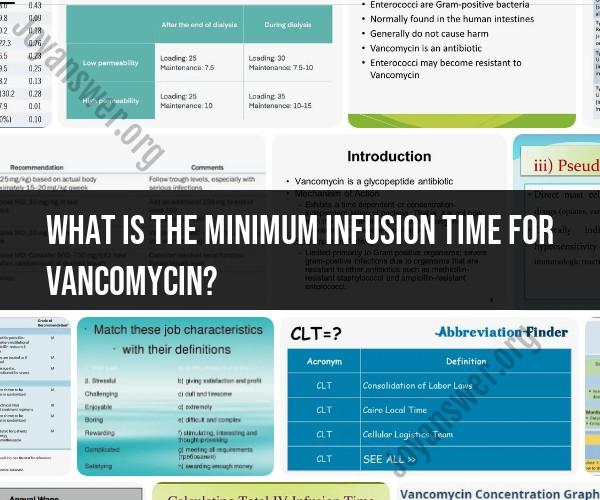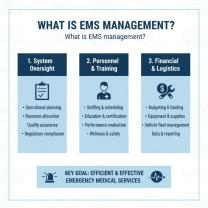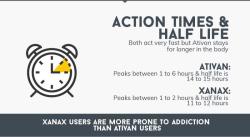What is the minimum infusion time for vancomycin?
The minimum infusion time for vancomycin, an antibiotic, is typically determined based on the concentration of the vancomycin solution and the patient's renal function. It's essential to follow the dosing guidelines and recommendations provided by the prescribing healthcare professional, as well as the instructions on the medication label and package insert. Generally, the following guidelines are commonly used for vancomycin infusion times:
Standard Infusion Time: For most adult patients with normal renal function, the standard infusion time for vancomycin is about 1 to 2 hours. This means the medication is typically administered over a 1- to 2-hour period.
Prolonged Infusion: In some cases, particularly when treating severe infections caused by certain strains of bacteria, healthcare providers may opt for a prolonged infusion time. This can extend the infusion to 2.5 to 3 hours or even longer, depending on the specific clinical situation.
Renal Impairment: For patients with impaired renal function (kidney function), the infusion time may need to be adjusted, and the total dose of vancomycin may be reduced. Slower infusion rates may be used to minimize the risk of kidney-related side effects.
It's crucial to remember that vancomycin should be administered under the guidance and supervision of a healthcare professional, typically in a clinical setting. The healthcare provider will calculate the appropriate dose and infusion time based on the patient's weight, renal function, and the type and severity of the infection being treated.
Improper administration of vancomycin, including infusing it too quickly, can lead to adverse effects, including kidney damage. Therefore, healthcare professionals closely monitor patients during vancomycin administration to ensure that it is administered safely and effectively. Patients should also inform their healthcare provider about any allergies, medical conditions, or other medications they are taking, as these factors can affect the dosage and infusion time of vancomycin.
Minimum Infusion Time for Vancomycin: Safety and Efficacy Guidelines
The minimum infusion time for vancomycin is 60 minutes, and this is regardless of the dose. This is to reduce the risk of infusion-related reactions, which are more common with rapid infusion. Infusion-related reactions can range from mild (e.g., flushing, pruritus) to severe (e.g., anaphylaxis).
Understanding the Importance of Proper Vancomycin Infusion
Proper vancomycin infusion is important for both safety and efficacy. Rapid infusion can increase the risk of infusion-related reactions, and it can also lead to suboptimal vancomycin levels. This is because vancomycin is a concentration-dependent antibiotic, meaning that higher concentrations are required for better bacterial killing.
Dosage, Administration, and Infusion Protocols for Vancomycin
The dosage, administration, and infusion protocols for vancomycin vary depending on the patient's age, weight, renal function, and the indication for use. However, some general guidelines are as follows:
- Adults: The usual dose of vancomycin for adults is 15-20 mg/kg/day, divided into 2-4 doses. The maximum dose is 4 grams per day.
- Children: The usual dose of vancomycin for children is 10-15 mg/kg/day, divided into 2-4 doses. The maximum dose is 2 grams per day.
- Infants: The usual dose of vancomycin for infants is 10-15 mg/kg/day, divided into 2-3 doses. The maximum dose is 1 gram per day.
Vancomycin is typically administered intravenously, and it should be infused over a period of at least 60 minutes.
Patient Care and Monitoring During Vancomycin Infusion
Patients receiving vancomycin should be monitored for signs and symptoms of infusion-related reactions. These reactions typically occur within 20 minutes of starting the infusion, but they can occur later. If an infusion-related reaction occurs, the infusion should be stopped immediately and supportive care provided.
Patients should also be monitored for signs and symptoms of vancomycin toxicity. These signs and symptoms can include nephrotoxicity (e.g., decreased urine output, increased creatinine), ototoxicity (e.g., hearing loss, tinnitus), and neutropenia.
Advancements in Vancomycin Delivery and Treatment
There have been a number of advancements in vancomycin delivery and treatment in recent years. One advancement is the development of continuous infusion vancomycin. Continuous infusion vancomycin has been shown to be more effective and safer than intermittent dosing, especially in patients with severe infections.
Another advancement is the development of new vancomycin formulations. For example, there is now a vancomycin formulation that can be administered orally. This formulation is useful for patients who have difficulty tolerating intravenous vancomycin or who have infections that do not require intravenous therapy.
Overall, vancomycin is a safe and effective antibiotic, but it is important to administer it properly. By following the guidelines above, healthcare professionals can help to ensure that patients receive the best possible treatment with vancomycin.













